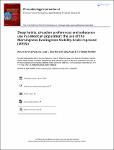| dc.contributor.author | Arrona-Palacios, Arturo | |
| dc.contributor.author | Díaz-Morales, Juan Francisco | |
| dc.contributor.author | Adan, Ana | |
| dc.contributor.author | Randler, Christoph | |
| dc.contributor.editor | Smolensky, Michael | |
| dc.date.accessioned | 2020-10-23T18:56:31Z | |
| dc.date.available | 2020-10-23T18:56:31Z | |
| dc.date.issued | 2020-10-30 | |
| dc.identifier.citation | Arrona-Palacios, A., Díaz-Morales, J.F., Adan, A., Randler, C. (2020). Sleep habits, circadian preferences and substance use in a Mexican population: the use of the Morningness-Eveningness-Stability-Scale improved (MESSi). Chronobiology International, 37, 111-122 | es_MX |
| dc.identifier.issn | 0742-0528 | |
| dc.identifier.doi | https://doi.org/10.1080/07420528.2019.1688339 | |
| dc.identifier.uri | https://hdl.handle.net/11285/636816 | |
| dc.description.abstract | This study aimed to validate the Morningness-Eveningness-Stability-Scale improved (MESSi) in Mexico, analyzing the factor structure and sleep habits, combined with the proposal of cutoff values for the scales, and to assess the relationship with substance use. We applied the questionnaires through an online survey to a total sample of 510 Mexicans, aged 18–77 years (M =27.79, SD = 10.24). The MESSi showed an acceptable fit and the Cronbach’s alpha coefficients were good to satisfactory in the Mexican sample in every subscale: Morning Affect (MA, α = 0.90), Eveningness (EV, α = 0.88), Distinctness (DI, α = 0.80). In order to obtain a better interpretation of the MESSi subscales, we decided to propose cutoff points corresponding to the 25th–75th percentile. The categories were depicted as strong trait presence, intermediate trait presence and weak trait presence. When applying the cutoff points for the MESSi sub-scales, with Morning Affect (MA), strong-types went to bed and woke up earlier and had more sleep than weak-types during weekdays and weekends and reported less social jetlag. For Eveningness (EV), strong-types went to bed and woke up later than weak-types on weekdays and weekends. Also, strong-types had a shorter time in bed during weekdays but not on weekends and reported more social jetlag. Lastly, with Distinctness (DI), the results reported that those with a strong-type showed greater amplitude on weekdays and weekends. Furthermore, the MESSi scale found that evening people consumed more alcohol and tobacco. Our study supported the validity and reliability of the MESSi in a Mexican population and the relationship between eveningness and substance consumption. Furthermore, the proposed cutoff scores for the MESSi sub-scales add a novel approach for the measurement and interpretation of the scale. | es_MX |
| dc.format.medium | Texto | es_MX |
| dc.language.iso | eng | es_MX |
| dc.publisher | Taylor & Franciss | es_MX |
| dc.relation | Spanish Ministry of Economy, Industry and Competitiveness PSI2016-76552 | es_MX |
| dc.relation | Spanish Ministry of Economy, Industry and Competitiveness PSI2015-65026 | es_MX |
| dc.relation.isFormatOf | versión publicada | es_MX |
| dc.relation.url | https://www.tandfonline.com/doi/abs/10.1080/07420528.2019.1688339?journalCode=icbi20 | es_MX |
| dc.rights | embargoedAccess | es_MX |
| dc.rights.uri | http://creativecommons.org/licenses/by-nc-nd/4.0 | es_MX |
| dc.subject | MEDICINA Y CIENCIAS DE LA SALUD::CIENCIAS MÉDICAS | es_MX |
| dc.subject.lcsh | Medicine | es_MX |
| dc.title | Sleep habits, circadian preferences and substance use in a Mexican population: the use of the Morningness-Eveningness-Stability-Scale improved (MESSi) | es_MX |
| dc.type | Artículo/Article | es_MX |
| dc.identifier.journal | Chronobiology International | es_MX |
| dc.rights.embargoreason | Embargoes apply if you are posting your AM to an institutional or subject repository, or to a scholarly collaboration network such as ResearchGate, Mendeley, or Academia.edu | es_MX |
| dc.identifier.orcid | https://orcid.org/0000-0003-0828-3327 | es_MX |
| dc.identifier.orcid | https://orcid.org/0000-0002-3894-7908 | es_MX |
| dc.identifier.orcid | https://orcid.org/0000-0002-3328-3452 | es_MX |
| dc.identifier.orcid | https://orcid.org/0000-0002-7357-2793 | es_MX |
| dc.subject.keyword | Morningness-Eveningness | es_MX |
| dc.subject.keyword | MESSi | es_MX |
| dc.subject.keyword | substance consumption | es_MX |
| dc.subject.keyword | chronotype | es_MX |
| dc.subject.keyword | sleep | es_MX |
| dc.description.notes | This is an original preprint of an article published by Taylor & Francis in Chronobiology International, on october. 2020, available online: http://www.tandfonline.com/https://doi.org/10.1080/07420528.2019.1688339. | es_MX |
| dc.identifier.volume | 37 | es_MX |
| dc.identifier.issue | 1 | es_MX |
| dc.identifier.startpage | 111 | es_MX |
| dc.identifier.endpage | 122 | es_MX |
| dc.contributor.affiliation | Instituto Tecnológico y de Estudios Superiores de Monterrey | es_MX |
| dc.subject.country | México / Mexico | es_MX |
| dc.identificator | 3||32 | es_MX |
| dc.date.embargoenddate | 2021-12-01 | |

